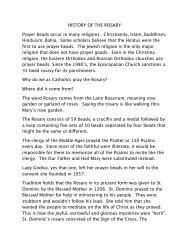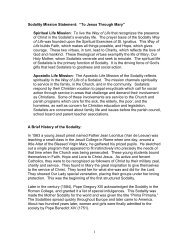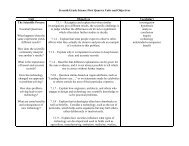+ 8th Grade Science - 1st Quarter Goals (PDF)
+ 8th Grade Science - 1st Quarter Goals (PDF)
+ 8th Grade Science - 1st Quarter Goals (PDF)
You also want an ePaper? Increase the reach of your titles
YUMPU automatically turns print PDFs into web optimized ePapers that Google loves.
Eighth <strong>Grade</strong> First <strong>Quarter</strong> <strong>Science</strong> Units and Objectives<br />
Unit Objectives Vocabulary<br />
The Scientific Process 8.1.1 – Recognize that and describe how scientific knowledge<br />
is subject to modification as new information challenges<br />
Essential Questions: prevailing theories and as a new theory leads to looking at old<br />
observations in a new way.<br />
When is the scientific<br />
process useful, and<br />
when is it not?<br />
What is a variable?<br />
Why is it important to<br />
keep all variables<br />
constant except one?<br />
How is the development<br />
of new technology<br />
affected by culture?<br />
8.1.2 – Recognize and explain that some matters cannot be<br />
examined usefully in a scientific way.<br />
8.1.3 – Recognize and describe that if more than one variable<br />
changes at the same time in an experiment, the outcome of the<br />
experiment may not be attributable to any one of the<br />
variables.<br />
8.2.9 – Explain why arguments are invalid if based on very<br />
small samples of data, biased samples, or samples for which<br />
there was no control sample.<br />
8.2.10 – Identify and criticize the reasoning in arguments in<br />
which fact and opinion are intermingled or the conclusions do<br />
not follow logically from the evidence given, an analogy is<br />
not apt, no mention is made of whether the control group is<br />
very much like the experimental group, or all members of a<br />
group are implied to have nearly identical characteristics that<br />
differ from those of other groups.<br />
8.1.4 – Explain why accurate record keeping, openness, and<br />
replication are essential for maintaining an investigator’s<br />
credibility with other scientists and society.<br />
8.1.5 – Explain why research involving human subjects<br />
requires that potential subjects be fully informed about the<br />
risks and benefits associated with the research and that they<br />
theory<br />
variable<br />
control<br />
procedural summary<br />
independent variable<br />
dependent variable<br />
constant<br />
technology
Eighth <strong>Grade</strong> First <strong>Quarter</strong> <strong>Science</strong> Units and Objectives<br />
Systems on Earth<br />
Essential Questions:<br />
What are the different<br />
layers of Earth?<br />
How are the continents<br />
and ocean basins<br />
constantly changing?<br />
What causes<br />
earthquakes and<br />
volcanoes?<br />
Why is it important to<br />
have the right to refuse to participate.<br />
8.1.6 – Identify the constraints that must be taken into account<br />
as a new design is developed, such as gravity and the<br />
properties of the materials used.<br />
8.1.7 – Explain why technology issues are rarely simple and<br />
one-sided because contending groups may have different<br />
values and priorities.<br />
8.1.8 – Explain that humans help shape the future by<br />
generating knowledge, developing new technologies, and<br />
communicating ideas to others.<br />
8.2.6 – Write clear, step-by-step instructions (procedural<br />
summaries) for conducting investigations, operating<br />
something, or following a procedure.<br />
8.3.1 – Explain that large numbers of chunks of rock orbit the<br />
sun and some of this rock interacts with Earth.<br />
8.3.5 – Explain that everything on or anywhere near Earth is<br />
pulled toward Earth’s center by a gravitational force.<br />
8.3.3 – Explain that the solid crust of Earth, including both the<br />
continents and the ocean basins, consists of separate plates<br />
that ride on a denser, hot, gradually deformable layer of earth.<br />
Understand that the crust sections move very slowly, pressing<br />
against one another in some places, pulling apart in other<br />
places. Further understand that ocean-floor plates may slide<br />
under continental plates, sinking deep into Earth, and that the<br />
surface layers of these plates may fold, forming mountain<br />
ranges.<br />
orbit<br />
gravity<br />
gravitational force<br />
crust<br />
mantle<br />
outer core<br />
inner core<br />
magma<br />
lava<br />
continental plates<br />
tectonic plates<br />
continental drift theory<br />
Pangaea<br />
Laurasia<br />
Gondwanaland<br />
divergent boundary
Eighth <strong>Grade</strong> First <strong>Quarter</strong> <strong>Science</strong> Units and Objectives<br />
conserve Earth’s<br />
resources and keep it<br />
clean?<br />
8.3.2 – Explain that the slow movement of material within<br />
Earth results from heat flowing out of the deep interior and<br />
the action of gravitational forces on regions of different<br />
density.<br />
8.3.4 – Explain that earthquakes often occur along the<br />
boundaries between colliding plates, and molten rock from<br />
below creates pressure that is released by volcanic eruptions,<br />
helping to build up mountains. Understand that under the<br />
ocean basins, molten rock may well up between separating<br />
plates to create new ocean floor. Further understand that<br />
volcanic activity along the ocean floor may form undersea<br />
mountains, which can thrust above the ocean’s surface to<br />
become islands.<br />
8.5.5 – Illustrate that it takes two numbers to locate a point on<br />
a map or any other two-dimensional surface.<br />
8.6.7 – Illustrate how things, such as seasons or body<br />
temperature, occur in cycles.<br />
8.3.6 – Understand and explain that the benefits of Earth’s<br />
resources, such as fresh water, air, soil, and trees, are finite<br />
and can be reduced by using them wastefully or by<br />
deliberately or accidentally destroying them.<br />
8.3.7 – Explain that the atmosphere and the oceans have a<br />
limited capacity to absorb wastes and recycle materials<br />
naturally.<br />
8.6.1 – Explain that a system usually has some properties that<br />
are different from those of its parts but appear because of the<br />
interaction of those parts.<br />
convergent boundary<br />
transform boundary<br />
seafloor spreading<br />
mid-ocean ridge<br />
mountain range<br />
subduction zone<br />
earthquake<br />
volcano<br />
hot spot<br />
natural resource
Eighth <strong>Grade</strong> First <strong>Quarter</strong> <strong>Science</strong> Units and Objectives<br />
8.6.2 – Explain that even in some very simple systems, it may<br />
not always be possible to predict accurately the result of<br />
changing some part or connection.<br />
8.6.5 – Observe and describe that a system may stay the same<br />
because nothing is happening or because things are happening<br />
that counteract one another.












